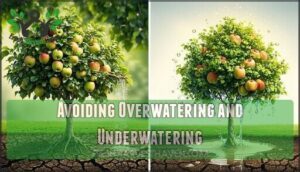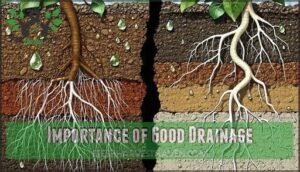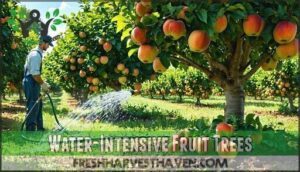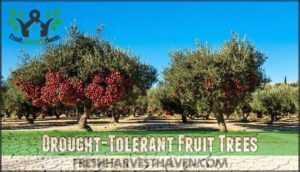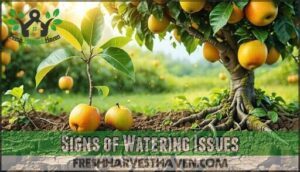This site is supported by our readers. We may earn a commission, at no cost to you, if you purchase through links.

Young trees need water 2-3 times weekly, checking that moisture reaches 12-18 inches deep for strong root development.
Mature trees require deeper, less frequent watering—about 10-20 gallons monthly during dry spells.
Climate matters too: desert areas demand daily watering while humid regions need weekly sessions.
Always water early morning to reduce evaporation and prevent fungal problems.
Check soil moisture by pushing your finger 2 inches down—if it’s dry, it’s time to water deeply.
Proper drainage prevents root rot while deep watering creates resilient trees that’ll reward your efforts with abundant harvests.
Table Of Contents
- Key Takeaways
- Watering Frequency Matters
- Proper Watering Techniques
- Fruit Tree Water Requirements
- Efficient Irrigation Systems
- Signs of Watering Issues
- Frequently Asked Questions (FAQs)
- Which is the best technique for watering fruit plants?
- Should you water fruit trees every day?
- How often should I water fruit trees in 100 degree weather?
- How long to water fruit trees with a hose?
- Can rainwater alone sustain my fruit trees?
- Whats the best watering schedule for container trees?
- How does tree spacing affect watering needs?
- Should I water differently during fruit development?
- Can automated timers replace manual watering monitoring?
- What time of day is best for watering fruit trees?
- Conclusion
Key Takeaways
- Check soil moisture before watering – Push your finger 2 inches into the soil near the tree base; if it’s dry, water deeply rather than following a rigid schedule
- Water deeply but less frequently – Young trees need 2-3 weekly watering sessions that reach 12-18 inches deep, while mature trees require 10-20 gallons monthly during dry spells
- Time your watering for early morning – You’ll reduce evaporation losses and prevent fungal problems that develop when leaves stay wet overnight
- Match your method to your tree’s needs – Use drip irrigation for 90-95% efficiency, or try soaker hoses for budget-friendly deep watering that targets the root zone
Watering Frequency Matters
You’ll discover that watering frequency isn’t one-size-fits-all—it depends on your tree’s age, your local climate, and the season.
Getting the timing right means the difference between a thriving orchard and struggling trees that waste your time and money.
Young Tree Watering Needs
Most young trees require careful attention to establish healthy root development and guarantee long-term success. Think of them as seedlings learning to thrive—they need consistent care but not overwhelming attention.
Like seedlings learning to thrive, young fruit trees need consistent care without overwhelming attention.
Like a watchful gardener reading nature’s cues, proper mulching whispers moisture secrets to patient roots
Your young trees depend on you for proper initial hydration during their critical first years. Frequent monitoring helps you catch problems before they become serious issues.
Follow this watering approach for ideal growth support:
- Frequency: Water 2-3 times weekly, checking soil saturation levels between sessions
- Depth: Ensure water reaches 12-18 inches deep to encourage strong root systems
- Timing: Water early morning to reduce evaporation and prevent fungal issues.
Deep watering trees promotes robust root development better than shallow, frequent applications. This watering technique for fruit trees builds the foundation your trees need to flourish for decades.
Mature Tree Watering Needs
When mature trees establish their extensive root depth, they need less frequent watering than young ones.
Watering mature trees requires 10-20 gallons during dry periods, depending on soil type and fruit load.
Focus on deep watering trees monthly rather than frequent shallow sessions.
This watering frequency promotes tree health by encouraging roots to grow deeper, creating resilient fruit trees.
Climate Influence on Watering
Your climate controls how thirsty your fruit trees get—think of it as nature’s water meter running constantly in the background.
Like a utility bill that never stops running, your local climate dictates exactly how much water your trees will demand
Regional Variations create dramatically different watering schedules across the country.
Rainfall Patterns in the Pacific Northwest mean less supplemental watering, while Arizona gardeners might water daily.
Temperature Effects accelerate evaporation rates, forcing you to compensate with increased watering frequency.
Humidity Levels act like a moisture blanket, slowing water loss in coastal areas but speeding it up in dry mountain regions.
Climate factors that reshape your watering routine:
- Desert climates – Daily watering becomes standard as soil moisture levels plummet within hours
- Humid subtropical zones – Weekly deep watering suffices due to slower evaporation rates
- High-altitude Microclimates** – Intense UV and wind create surprising water demands despite cooler air
- Coastal regions – Ocean breezes maintain consistent humidity, reducing overall watering frequency substantially
Understanding your specific climate helps you read what your trees actually need.
Seasonal Adjustments for Watering
Seasonal adjustments keep your fruit trees thriving year-round through strategic watering schedule changes. Spring Watering kicks off as buds break, requiring 2-3 weekly sessions to fuel new growth. Summer Hydration demands daily attention in hot climates—think of it as your tree’s air conditioning bill.
Fall Preparation gradually reduces frequency as trees slow down, preparing for dormancy. Winter Dormancy needs minimal water, maybe monthly checks to prevent root damage. Drip irrigation is a great way to guarantee efficient water delivery to your trees.
Regional Variations matter more than calendar dates—your soil tells the real story through moisture levels and seasonal considerations.
Proper Watering Techniques
You’ll master proper watering techniques by checking soil moisture regularly and understanding your tree’s specific drainage needs.
Getting the balance right between too much and too little water makes all the difference for healthy, productive fruit trees.
Soil Moisture Checking Methods
Knowing when your trees need water isn’t guesswork. You can master soil moisture levels with simple techniques that prevent both drought stress and root rot.
- Finger Test: Push your finger 2 inches into soil near the base. If it feels dry, water deeply.
- Moisture Meters: Digital tools give precise readings of soil dryness levels below the surface. You can find tools for measuring soil moisture online.
- Auger Use: Drill 6-8 inches down to check deeper soil moisture that surface tests miss.
- Visual Cues: Watch for cracked soil or early leaf wilting as warning signs of inadequate moisture.
Avoiding Overwatering and Underwatering
Finding the perfect watering balance means avoiding two common problems that hurt your fruit trees.
Overwatering creates root rot when soggy soil suffocates roots, while underwatering causes leaf wilting and stunted growth.
You’ll spot overwatering through yellow leaves, musty soil odors, and fungal growth. Underwatering shows up as wilted foliage, cracked soil, and premature fruit drop.
Check soil moisture regularly using proper watering techniques for fruit trees to prevent these issues.
Overwatering Signs Underwatering Signs
Importance of Good Drainage
Three factors determine your fruit trees’ survival: water, nutrients, and drainage. Poor drainage kills more trees than drought ever could.
When water can’t escape, your trees literally suffocate. Root rot sets in fast, turning healthy roots into mushy, brown decay. Clay soil makes this worse by trapping water like a bathtub.
Here’s how to fix drainage problems:
- Add organic matter – Mix compost into clay soil for better soil aeration
- Install drainage tiles – Underground pipes carry excess water away from roots
- Create raised beds – Elevate trees above waterlogged ground
- Build drainage channels – Direct water flow away from tree bases
Good soil drainage prevents waterlogging effects while protecting against overwatering damage. To further improve water absorption, consider enhancing water retention with soil amendments. Your trees need oxygen at their roots just as much as water.
Soil Composition and Water Retention
Your soil type directly affects how much water your trees can actually use.
Sandy soil drains fast, requiring more frequent watering sessions, while clay soil holds moisture longer but risks waterlogging.
Adding organic matter like compost creates the perfect balance—improving drainage solutions and water retention simultaneously.
Test soil moisture regularly using the finger method.
Proper soil amendments guarantee healthy water percolation and root oxygenation for thriving fruit trees.
Fruit Tree Water Requirements
Different fruit trees have unique water needs that you’ll want to understand for successful growing. Some trees crave consistent moisture while others thrive with less water once they’re established.
Water-Intensive Fruit Trees
Thirsty trees demand your attention, especially in regards to apple watering, peach hydration, and citrus needs.
These water-intensive fruit trees—including avocados, bananas, and stone fruits—require consistent moisture throughout their growing season.
You’ll need to provide weekly deep watering, with mature avocados needing 25-40 gallons per week during hot conditions.
Proper watering techniques for fruit trees become essential during fruit development, when inadequate water reduces both yield and quality in these demanding varieties.
Drought-Tolerant Fruit Trees
While water-intensive trees demand constant moisture, drought-tolerant fruit trees offer an appealing alternative.
Selecting Varieties like pomegranates, figs, and olives means embracing Water Conservation without sacrificing harvest quality.
These resilient champions develop deep root systems through strategic Rootstock Influence, making Climate Adaptation effortless.
Once established, they thrive with Minimal Irrigation, proving that smart variety selection transforms your orchard into a water-wise paradise that laughs at drought stress.
Pomar dos Sabores maintains a database of species adapted to arid conditions.
Tree-Specific Watering Needs
When choosing watering techniques for fruit trees, remember that each species has unique requirements.
Citrus watering demands consistent moisture with excellent drainage to prevent root rot.
Apple watering needs deep, weekly sessions for young trees, then less frequent irrigation once established.
Peach watering requires steady hydration during fruit development to maintain quality.
Avocado needs include frequent but shallow watering due to sensitive surface roots.
Fig watering is minimal once established, as they’re naturally drought-tolerant.
For apple trees, this is a key consideration: overwatering is more harmful than underwatering.
Understanding these fruit tree types helps you match your watering techniques for fruit trees to each variety’s specific tree watering needs.
Factors Affecting Water Requirements
Multiple factors determine how much water your fruit trees need to thrive. Understanding these variables helps you create the perfect watering schedule for ideal growth and fruit production.
Tree Age substantially impacts watering frequency – young trees need consistent moisture while established ones require less attention.
Climate Impact and rainfall levels directly affect your watering routine, with hot summers demanding more frequent irrigation than mild seasons. Soil Type matters too, as sandy soils drain quickly while clay retains moisture longer.
Different fruit tree types have unique species needs. Citrus trees crave consistent soil moisture levels, while figs tolerate drought conditions better.
Your local climate patterns, combined with natural rainfall levels, guide when and how often you’ll need to supplement with additional watering. Consider climate compatibility when selecting your trees.
Efficient Irrigation Systems
You’ll find that choosing the right irrigation system can make the difference between thriving fruit trees and struggling ones.
The key is matching your watering method to your trees’ needs, your budget, and how much time you want to spend maintaining your orchard.
Drip Irrigation Benefits
Drip irrigation transforms water conservation for fruit trees by delivering precise amounts directly to the root zone.
This targeted approach achieves 90-95% water efficiency while eliminating waste from evaporation and reduced runoff. You’ll enjoy labor savings through automated scheduling that maintains consistent moisture levels.
The system’s precise delivery prevents soil compaction and wind interference, optimizing growing conditions. For thorough setup, consider complete irrigation systems.
Unlike sprinklers that water leaves and create disease risks, drip irrigation focuses solely on roots where it’s needed most, making it the gold standard among tree irrigation methods.
Soaker Hose Watering Method
Budget-conscious gardeners can achieve professional results with soaker hoses for fruit tree watering. These porous tubes deliver water slowly and evenly, creating the perfect deep watering techniques your trees crave.
Smart soaker placement around your tree’s drip line guarantees water reaches the entire root zone. Choose quality hose material that won’t clog easily – recycled rubber performs better than cheap plastic versions. You’ll want to run your system for the ideal duration of 30-45 minutes per session, allowing water to penetrate 12-18 inches deep. Consistent watering prevents stress induced disease.
Here’s your success checklist:
- Position hoses in circles around the drip line for even coverage
- Maintain 10-15 PSI pressure regulation to prevent uneven flow
- Install timers for consistent watering schedules
- Follow maintenance tips: flush monthly and store indoors during winter
- Monitor soil moisture to adjust timing as needed
This method saves water while promoting healthy root development in your fruit trees, which is essential for their overall health and can lead to increased fruit production with the right watering techniques and proper care.
Manual Watering Techniques
Hose watering gives you complete control over water placement and flow rate.
The bucket method uses containers with small holes for steady, deep soaking around each tree.
Watering cans work perfectly for young trees needing gentle, measured applications.
Hand watering lets you inspect tree health while delivering thorough hydration that promotes strong root development.
Irrigation System Efficiency Comparison
When choosing between watering techniques, numbers tell the real story. Drip irrigation delivers 90-95% efficiency compared to sprinkler systems at 70% and manual methods at just 50%. This translates to serious water savings and healthier trees.
- Drip vs Sprinkler systems: Drip irrigation reduces water waste by delivering precise amounts directly to roots, while sprinklers lose water to evaporation and runoff
- Manual vs Automated approaches: Automated drip systems maintain consistent watering schedules without daily oversight, though manual watering allows real-time adjustments
- Cost-Benefit Analysis reveals: Higher upfront costs for drip systems pay off through reduced water bills and improved fruit yields over time
Signs of Watering Issues
Recognizing the warning signs of watering problems helps you catch issues before they damage your fruit trees permanently.
You’ll save yourself frustration and protect your harvest by learning to spot these telltale symptoms early, which is crucial for maintaining healthy fruit trees.
Overwatering Symptoms
Even the best irrigation systems can’t prevent overwatering damage if you’re not careful.
Too much water suffocates your fruit trees’ roots, creating a cascade of problems you’ll spot quickly.
Leaf yellowing appears first—widespread across the canopy as oxygen-starved roots struggle.
You’ll notice that telltale soil odor, musty and unpleasant, around your tree’s base.
This signals root rot developing in waterlogged conditions.
Stunted growth follows as damaged roots can’t support healthy development.
Your soil stays consistently wet or spongy, even days after watering.
Fungal growth thrives in these soggy conditions, while wilting ironically occurs despite abundant moisture—the classic signs of overwatering that confuse many gardeners.
Underwatering Symptoms
Thirsty fruit trees send clear distress signals when they’re not getting enough water.
Recognizing these signs of underwatering helps you act before permanent damage occurs.
Your trees will show these unmistakable symptoms:
- Wilting leaves that droop and curl inward as moisture disappears
- Leaf scorch creating brown, crispy edges from severe dehydration
- Stunted growth where new shoots stop developing completely
- Fruit drop as trees sacrifice developing fruit to survive
Dry soil compounds these problems, making leaf drop inevitable.
Don’t wait until wilting leaves become permanent damage.
Importance of Deep Watering
When you skip watering your fruit trees properly, you’re missing the secret to tree health.
Deep watering pushes root development downward, creating stronger foundations than shallow sprinkling ever could.
| Deep Watering Benefits | Shallow Watering Problems |
|---|---|
| Roots reach 12-18 inches deep | Roots stay at surface level |
| Enhanced drought resistance | Trees struggle in dry spells |
| Better nutrient uptake from soil | Limited access to minerals |
| Improved soil aeration naturally | Compacted, waterlogged conditions |
Your watering techniques shape how your fruit trees survive tough seasons.
Root health depends on encouraging downward growth, while proper soil moisture distribution feeds trees from below ground up.
Mulching for Moisture Retention
Mulch serves as nature’s moisture-saving blanket, cutting water evaporation by up to 70% around your fruit trees.
Apply organic mulch like wood chips, straw, or shredded leaves in a 3-4 inch layer, keeping it several inches from the trunk to prevent pest issues. Consider different mulch options for superior results.
Here’s your mulching checklist:
- Choose organic matter – Wood chips, bark, or compost work best
- Maintain proper application depth – 3-4 inches for maximum soil moisture retention
- Create a donut shape – Keep mulch away from tree trunk
- Replace annually – Fresh mulch alternatives guarantee continued water conservation benefits
Frequently Asked Questions (FAQs)
Which is the best technique for watering fruit plants?
Drip irrigation delivers the most efficient watering by providing measured water directly to your fruit tree’s root zone, reducing waste by 50% while promoting deep, healthy root growth.
Should you water fruit trees every day?
Like a garden’s heartbeat, fruit trees don’t need daily drinks.
You’ll overwhelm their roots with constant watering.
Instead, water deeply once or twice weekly, letting soil dry between sessions for healthier growth, with healthier growth being the goal.
How often should I water fruit trees in 100 degree weather?
In 100-degree weather, water your fruit trees twice weekly with deep soaking. Young trees need more frequent watering—every 2-3 days. Check soil moisture regularly and mulch heavily.
How long to water fruit trees with a hose?
Water your fruit trees for 30-45 minutes using a slow trickle setting near the drip line.
This allows water to penetrate 12-18 inches deep, reaching the root zone effectively without wasteful runoff.
Can rainwater alone sustain my fruit trees?
Rainwater helps, provides moisture, supports growth—but you’ll likely need supplemental watering. Rainfall amounts vary seasonally, and your trees’ needs depend on species, age, and local climate conditions.
Whats the best watering schedule for container trees?
Container trees dry out faster than ground-planted ones, so check soil moisture daily.
Water deeply when the top inch feels dry, typically every 1-2 days in summer and 3-4 days in cooler weather.
How does tree spacing affect watering needs?
Closer spacing creates competition, deeper spacing promotes independence.
When you plant trees too close together, they’ll compete for water and nutrients, requiring more frequent irrigation to keep each tree healthy and productive.
This reorganization improves readability by grouping related ideas and using double newlines for visual separation.
Should I water differently during fruit development?
Yes, you’ll need to adjust your watering during fruit development.
Increase watering frequency when fruits are forming and growing, as trees need extra moisture for proper fruit sizing and quality.
Maintain consistent soil moisture to prevent fruit cracking or dropping.
Can automated timers replace manual watering monitoring?
While automated timers can’t fully replace your watchful eye, they’re a game-changer for consistent watering schedules.
You’ll still need to monitor soil moisture, adjust for weather changes, and check your trees regularly for ideal health, which is crucial for their consistent growth and well-being.
What time of day is best for watering fruit trees?
Early morning is ideal for watering fruit trees.
You’ll give roots time to absorb moisture before heat evaporates it, and leaves dry quickly, preventing fungal diseases that thrive in overnight dampness.
Conclusion
Successfully nurturing your fruit trees doesn’t have to feel like walking through a minefield of potential mistakes.
You’ve learned that mastering watering techniques for fruit trees involves understanding your tree’s specific needs, checking soil moisture regularly, and adjusting your approach based on climate and season.
Remember to water deeply but less frequently, choose the right irrigation method, and watch for signs of stress.
With these proven strategies, you’ll cultivate thriving trees that produce bountiful harvests year after year.


